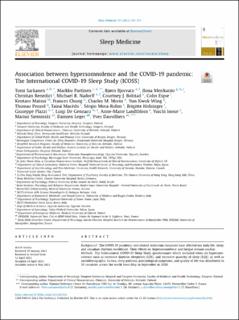Association between hypersomnolence and the COVID-19 pandemic: The International COVID-19 Sleep Study (ICOSS)
| dc.contributor.author | Sarkanen, Tomi | |
| dc.contributor.author | Partinen, Markku | |
| dc.contributor.author | Bjorvatn, Bjørn | |
| dc.contributor.author | Merikanto, Ilona | |
| dc.contributor.author | Benedict, Christian | |
| dc.contributor.author | Nadorff, Michael R. | |
| dc.contributor.author | Bolstad, Courtney J. | |
| dc.contributor.author | Espie, Colin | |
| dc.contributor.author | Matsui, Kentaro | |
| dc.contributor.author | Chung, Frances | |
| dc.contributor.author | Morin, Charles M. | |
| dc.contributor.author | Wing, Yun Kwok | |
| dc.contributor.author | Penzel, Thomas | |
| dc.contributor.author | Macêdo, Tainá | |
| dc.contributor.author | Mota-Rolim, Sérgio | |
| dc.contributor.author | Holzinger, Brigitte | |
| dc.contributor.author | Plazzi, Giuseppe | |
| dc.contributor.author | De Gennaro, Luigi | |
| dc.contributor.author | Landtblom, Anne-Marie | |
| dc.contributor.author | Inoue, Yuichi | |
| dc.contributor.author | Sieminski, Mariuz | |
| dc.contributor.author | Leger, Damien | |
| dc.contributor.author | Dauvilliers, Yves | |
| dc.date.accessioned | 2024-02-01T14:08:01Z | |
| dc.date.available | 2024-02-01T14:08:01Z | |
| dc.date.created | 2023-06-21T11:00:40Z | |
| dc.date.issued | 2023 | |
| dc.identifier.issn | 1389-9457 | |
| dc.identifier.uri | https://hdl.handle.net/11250/3115105 | |
| dc.description.abstract | Background The COVID-19 pandemic and related restriction measures have affected our daily life, sleep, and circadian rhythms worldwide. Their effects on hypersomnolence and fatigue remain unclear. Methods The International COVID-19 Sleep Study questionnaire which included items on hypersomnolence such as excessive daytime sleepiness (EDS), and excessive quantity of sleep (EQS), as well as sociodemographic factors, sleep patterns, psychological symptoms, and quality of life was distributed in 15 countries across the world from May to September in 2020. Results Altogether responses from 18,785 survey participants (65% women, median age 39 years) were available for analysis. Only 2.8% reported having had COVID-19. Compared to before the pandemic, the prevalence of EDS, EQS, and fatigue increased from 17.9% to 25.5%, 1.6%–4.9%, and 19.4%–28.3% amid the pandemic, respectively. In univariate logistic regression models, reports of having a COVID-19 were associated with EQS (OR 5.3; 95%-CI 3.6–8.0), EDS (2.6; 2.0–3.4), and fatigue (2.8; 2.1–3.6). In adjusted multivariate logistic regression, sleep duration shorter than desired (3.9; 3.2–4.7), depressive symptoms (3.1; 2.7–3.5), use of hypnotics (2.3; 1.9–2.8), and having reported COVID-19 (1.9; 1.3–2.6) remained strong predictors of EDS. Similar associations emerged for fatigue. In the multivariate model, depressive symptoms (4.1; 3.6–4.6) and reports of having COVID-19 (2.0; 1.4–2.8) remained associated with EQS. Conclusions A large increase in EDS, EQS, and fatigue occurred due to the COVID-19 pandemic, and especially in self-reported cases of COVID-19. These findings warrant a thorough understanding of their pathophysiology to target prevention and treatment strategies for long COVID condition. | en_US |
| dc.language.iso | eng | en_US |
| dc.publisher | Elsevier | en_US |
| dc.rights | Navngivelse 4.0 Internasjonal | * |
| dc.rights.uri | http://creativecommons.org/licenses/by/4.0/deed.no | * |
| dc.title | Association between hypersomnolence and the COVID-19 pandemic: The International COVID-19 Sleep Study (ICOSS) | en_US |
| dc.type | Journal article | en_US |
| dc.type | Peer reviewed | en_US |
| dc.description.version | publishedVersion | en_US |
| dc.rights.holder | Copyright 2023 The Author(s) | en_US |
| cristin.ispublished | true | |
| cristin.fulltext | original | |
| cristin.qualitycode | 1 | |
| dc.identifier.doi | 10.1016/j.sleep.2023.04.024 | |
| dc.identifier.cristin | 2156507 | |
| dc.source.journal | Sleep Medicine | en_US |
| dc.source.pagenumber | 108-115 | en_US |
| dc.identifier.citation | Sleep Medicine. 2023, 107, 108-115. | en_US |
| dc.source.volume | 107 | en_US |

